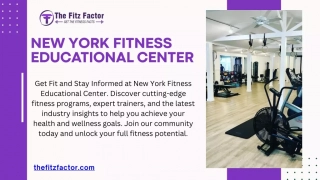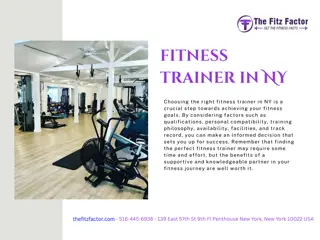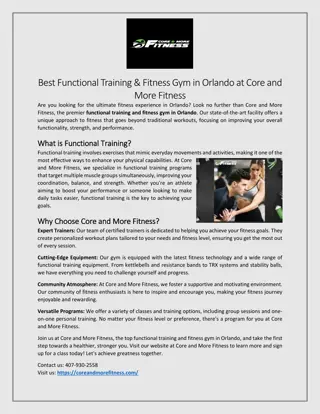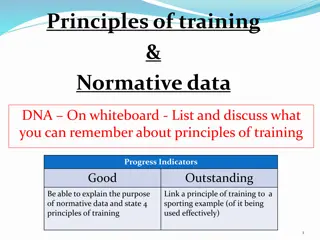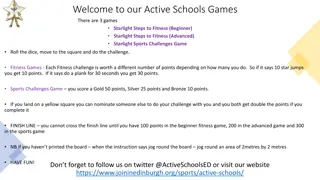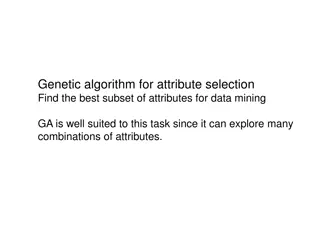
The Future of FitTech_ How 5G, Wearables, and AI are Transforming Fitness App Development
nThe fitness world is being radically reshaped by emerging technologies like 5G, wearable devices, and artificial intelligence. These innovations are powering the next generation of fitness apps that offer hyper-personalized, immersive, and interactive experiences. This blog explores how these technologies will transform fitness application development.
Download Presentation

Please find below an Image/Link to download the presentation.
The content on the website is provided AS IS for your information and personal use only. It may not be sold, licensed, or shared on other websites without obtaining consent from the author. If you encounter any issues during the download, it is possible that the publisher has removed the file from their server.
You are allowed to download the files provided on this website for personal or commercial use, subject to the condition that they are used lawfully. All files are the property of their respective owners.
The content on the website is provided AS IS for your information and personal use only. It may not be sold, licensed, or shared on other websites without obtaining consent from the author.
E N D
Presentation Transcript
The Future of FitTech: How 5G, Wearables, and AI are Transforming Fitness App Development ================================================= The global fitness mobile app development market is booming, expected to grow at over 13% CAGR to reach $14.7 billion by 2026, according to a study. But as competition intensifies, offering generic workout programs is no longer enough. Users expect fitness apps to act as advanced virtual coaches and provide bespoke guidance based on their changing fitness levels, goals, and preferences. New technologies like 5G, wearables, and AI are making it possible to offer such dynamic and personalized fitness experiences. As these technologies become more ubiquitous over the next decade, they will redefine fitness application development and experiences. Source 5G Connectivity usher in Real-Time Fitness Experiences The rollout of high-speed 5G networks offers game-changing capabilities for fitness apps compared to 4G or WiFi. For both outdoor and indoor fitness apps, 5G enables an array of real-time use cases not possible before.
Reduced Latency Enables Real-time Tracking and Feedback 5G offers sub-1ms latency compared to the 50-100ms latency of 4G networks. This allows fitness apps to provide real-time tracking and feedback without any lags or interruptions. Users can get moment-to-moment updates on running pace, heart rate zones, rep counts, and other metrics during workouts without latency hampering the experience. For example, the Fiit app provides real-time feedback during workouts by leveraging 5G's low latency capabilities. This creates an immersive experience where users feel like they have a virtual personal trainer by their side. High-definition Streaming for Immersive Fitness 5G s faster bandwidths, ranging from 100 Mbps to 1 Gbps, support high-definition live streaming of workout classes. Apps like FightCamp are using 5G to provide lag-free boxing and HIIT class streaming in up to 8K resolution. This high visual quality, coupled with minimal buffering, results in highly immersive fitness experiences. Additionally, 5G enables Multiplayer VR fitness gaming where groups can participate together in fast-paced VR workouts or training games. Zwift, a popular indoor cycling app, now supports 50 players together in a 5G-powered virtual world. Such interactive experiences will become more mainstream as 5G coverage rises globally. Image Uninterrupted Tracking for Outdoor Fitness For outdoor activities like running or cycling, 5G allows fitness apps to provide constant biometric tracking and mapping without any drop-offs in connectivity. As users move through different areas, their workout data can be continuously uploaded to the cloud rather than having intermittent gaps. Apps like NURVV Run leverage 5G to offer uninterrupted foot strike analysis and running coaching in real-time. This leads to outdoor fitness experiences
where users feel seamlessly connected throughout. As more gyms, stadiums, trails, parks and cities become 5G enabled over the next few years, it will expand the possibilities for creating fitness experiences powered by real-time data. Wearable Devices for 24/7 Fitness Tracking Wearable devices have become massively popular for continuous fitness tracking as well as receiving real-time guidance during workouts. According to IDC, shipments of wearable bands and watches will cross 160 million units globally. By seamlessly incorporating wearable tech, fitness apps can tap into a constant stream of biometric data and provide personalized recommendations. Image Enhanced Tracking with Advanced Sensors Next-generation comprehensive data on the wearer s exercise performance, recovery, sleep, and overall health 24/7. For example, the WHOOP 4.0 band uses 5 LEDs for accurate heart rate measurement, an accelerometer, a gyroscope, and a SpO2 sensor to track advanced strain, sleep, and recovery metrics. Deriving such granular data allows fitness apps to offer tailored insights and feedback to the user. wearables are equipped with sophisticated sensors to capture Wearables with electromyography (EMG) sensors, like the Myontec Mbody shorts, can track muscle contractions and exercise intensity. This enables apps to identify imbalances or optimize hypertrophy and strength programs based on an individual s biomechanics. Personalized Guidance through Wearable Integration
Leading apps like Apple Fitness+, Peloton, Nike Run Club, and MyFitnessPal seamlessly sync up data from wearables to offer customized fitness experiences. Wearable integration allows these apps to: - Provide real-time metrics like heart rate and pacing without needing to glance at the wearable device - Retain workout data like GPS maps, totals stats, and rep counts within the app for post-workout review - Offer tailored workout recommendations and training plans based on the user s fitness patterns and recovery needs observed through the wearable - Provide form correction, technique analysis, and safety alerts based on real-time data like unstable heart rate or dangerous exercise form ImageAs wearables become mainstream, they will be integral to fitness apps, creating personalized experiences driven by users' own quantified biometrics data. AI and Machine Learning for Adaptive Training Sophisticated AI is enabling fitness apps to act as smart virtual coaches that customize guidance to each user and adapt plans based on changing fitness levels and goals. Workout Personalization through ML Recommendation Engines Machine Learning algorithms analyze users performance, feedback, goals, and other engagement data to build a fitness app recommendation engine. These engines suggest tailored workout routines, training plans, gear, playlists, challenges and other features personalized for each user. As apps gather more data over time, their ML models improve, and the level of customization increases. AI can even design entirely new workouts optimized for a user s needs instead of recommending pre-defined programs. Image Intelligent Form Tracking and Correction
Computer vision techniques like pose estimation allow apps to track exercise form and provide real-time corrections before injury-causing mistakes become habits. For example, the Paofit app uses AI to analyze exercise repetitions in bodyweight workouts and detect suboptimal techniques. Users get tailored cues like straighten knees to improve form. Startups like Forsight use sensor fusion and deep learning on thermal video data to accurately track movement patterns across both sides of the body during rehab exercises. Such intelligent form tracking will be critical to prevent injuries as fitness application development becomes virtual personal trainers. Motivation through Personalized Insights Leveraging data from wearables and external apps via APIs, fitness platforms can gain a holistic context of users health metrics, sleep patterns, nutrition, and more. ImageAI can then derive personalized insights to nudge users and keep them motivated. For example, the fitness social network Strava analyzes runners training load and race performances to provide customized training recommendations and predict potential race finish times. As privacy concerns are tackled, the combinatorial power of cross-app data will allow fitness platforms to offer hyper-personalized guidance based on the complete understanding of each user's body, lifestyle, and goals. The Future: Fitness Experiences Powered by 5G, Wearables and AI Emerging technologies will work together to redefine fitness mobile app development experiences over the next 5-10 years. Here are some exciting possibilities: Immersive Fitness Realms with Digital Humans 5G coupled with AR, VR, and AI, will enable apps to build your own fitness app worlds where users can have interactive workouts and competitions with virtual coaches, friends, or digital twins of real athletes and trainers. Spatial anchors can map digital assets like weights and instructors persistently into physical spaces for hybrid experiences.
ImageFor example, Holofitness uses AR to project holograms of trainers who can demonstrate moves from any angle and provide corrections in real-time during workouts. Such immersive fitness realms will make exercising at home as engaging as gym experiences. Fitness Apps Integrated with Smart Gym Equipment Wearables and IoT ecosystems will allow fitness app development solutions to connect with smart gym equipment to create data-driven workout experiences. Apps can auto-adjust equipment like smart treadmills based on changing heart rate or form breakdown. Biometric data can visualize intensity and output on screens to immerse users in the workout. Post-workout data can be integrated within fitness apps to provide feedback on form, training effect, areas of improvement and to optimize future exercise plans leveraging AI. This will blur the barrier between digital fitness experiences and physical gym equipment. Image Fitness Apps as Central Health Hubs In the future, fitness mobile app development will evolve into platforms for complete physical and mental health. Users will be able to seamlessly access nutrition planning, telehealth services, sleep tracking, stress management, and well-being features within a single app. Workout recommendations will factor in data across all these dimensions for whole-body optimization. Powerful analytics will provide insights on optimizing longevity, performance, and overall wellness. Conclusion
Emerging development into intelligent and highly personalized virtual coaches. However, there are challenges to building human-centric AI for fitness, including concerns around data privacy, algorithmic bias, and the need to keep users engaged. As 5G, wearables and AI evolve, fitness application developers should ensure they design experiences that adapt to human needs rather than forcing humans to adapt their behaviors to technology. Fitness app experiences must be joyful, intuitive, and effective at nudging people towards their goals. technologies hold enormous potential to transform fitness mobile app At Consagous Technologies, we are at the forefront of building next-gen fitness and health apps powered by data-driven insights. Our fitness application development experts create highly tailored apps that leverage AI and biometrics to provide users with the benefits of virtual coaching and community engagement towards achieving their wellness goals. We focus on an ethical approach to emerging technology, keeping users in control of their data and integrating human wisdom with algorithmic personalization. Contact our team to explore how our full-stack capabilities can bring your digital wellness and fitness vision to life with the strategic use of modern tech stacks.

